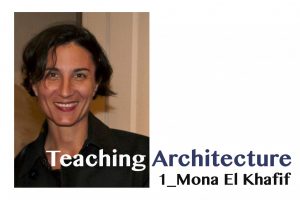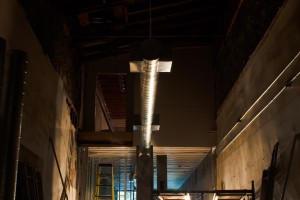Teaching Architecture is a series of interviews with faculty at the University of Waterloo School of Architecture. They are asked why they teach, what drives them, what brought them here, and their opinions on academia in architecture today. The conversations are motivating, inspirational, and reveal great stories about people who shape the way we learn today.
The following is a conversation with Terri Meyer Boake, a Professor at UWSA.
How did you begin to teach in Architecture & Design?
Terri: I started at Waterloo as a student in 1975 and graduated in 1982 with a Bachelor of Architecture. I graduated into a really tough recession. There was just no work for anybody. I had been a TA all the way through – I was the structures TA for Statics, Strength of Materials, Steel Concrete and Timber design from 3A to the end of 5B. I tried to work immediately after I graduated but didn’t find anything right away, so I was back helping to teach one of the structures courses. At the time, Larry Richards was the director. Both the professors that taught structures went on sabbatical at the same, which was kind of strange. So Larry invited me to teach those courses. Things were a lot less formal back then with a lot less rules. On the Concrete, Steel and Timber Design courses, I was given the freedom to do whatever I wanted to do. So I ended up changing the Steel and Concrete courses into Building Construction courses, because we didn’t have any building construction courses when I was going through school and I could personally feel that we needed them. It was just assumed we would go out on COOP and “pick up” the technology stuff. But that wasn’t happening because Waterloo students were really good at ink on mylar design drawings and so when you would go to offices on work terms, you would end up doing design drawings and not contract documents. So I decided to change those two courses the year that I was doing them into construction courses about steel and concrete, rather than the typical numbers based structures courses that had been taught. Which was probably quite illegal, but it happened. Meanwhile, we undertook a whole technology curriculum overhaul that I was also involved in. Ron Keenberg, who was a Winnipeg architect at a firm called IKOY, and a good friend of Larry Richards’, was quite involved in this revision. (You might know his work as he won the competition for the Davis Centre on Main Campus.) He came as an adjunct professor to do charrettes in studios with a huge focus on steel, enhanced detailing and requiring building mock-ups of details at a large scale.
We ended up doing this major overhaul of the whole (former) “Systems and Measures” stream while I was teaching as an adjunct from 1983 to 1986. Our old suite of courses consisted of: Calculus, Statistics, Statics, Strength of Materials, Structural Analysis, Indeterminate Structures, Steel, Concrete and Timber (yes 8 courses!) We got rid of the standard university required calculus and statistics courses. We invented a few new courses. I created a brand new courses called Mathematics in Architecture in which the first half of the term focused on perspective drawings and sacred geometry. We studied Alberti, Palladio, Serlio and how they used Math in drawing. The second half of the course looked at word problems to prep you for the structures courses. The other new course was called Theories and Technologies of Building which I taught with Thomas Seebohm and Donald McKay. It was a series of highly visual theory based lectures, some of which still exist in my courses today, looking at how technological change impacts the way we design. Additionally I created the two Building Construction courses, taking place in 1B and 2A.
At that time I was still working at Joseph Bogdan Associates, along with working as an adjunct, and I was involved in the curriculum changes, and I created four brand new technology courses. As well I ended up taking on teaching the timber course in the summer. It seemed like I was in good shape to transition to teaching full time with my suite of 5 courses, but Larry said to me, ‘well this is all well and good, but you really can’t have a full time job here because you don’t have a Masters degree’. And there has to be a full time opening.
Was your undergrad a professional degree?
Terri: Yes it was our old professional B.Arch. but deemed insufficient for applying for teaching (although many before me were able to teach with only a B.Arch.) I was living in Toronto, my husband was working in an office in Toronto. I thought, how am I going to get a Masters degree while I’m still doing all this stuff and without moving? I ended up doing a one year Masters degree at University of Toronto. It was a post professional degree, which was one of those nominal one year promises which became 16+ months. I did that so that I would have the Masters degree, so when the job I wanted at school was advertised, I could apply for that.
Finally there was an opening for a dedicated technology position when one of the professors (Joe Somfay) left for private practice. I applied for the technology position around 1986. I was shortlisted for the job…but I didn’t get it. I was 29, and female, and at that point we had zero female faculty. The guy that they hired was 39 and he was a mechanical engineer. So I was told by Larry and Donald McIntyre (who was interim director at the time) five minutes before I had to go in and teach the Timber class, that I in fact did not get the job that I had applied for. So I went in to teach this class and I felt that I had been hit by a truck. I had gone through all this work making the courses and getting that degree, and they said “no, you’re too young”. I wasn’t too young for all the other stuff, but I was somehow too young to have this job.
They hired the mechanical engineer and I was going to be unemployed that fall. And it was really interesting because he was a mechanical engineer and he had absolutely no ability to teach the four courses that I had created. Somehow, he decided he didn’t want the job – he was from New Brunswick, with a young family and his wife was a school teacher, and he didn’t want to relocate with only 6 weeks to the start of the fall term. So I ended up getting the job by default and I went to teach in the fall with my first contract position.
After a while there was another change in curriculum, driven by the design faculty, with a move to remove the Math and Technology courses in favour of the versions of Arch 100 and Arch 110 that we have now. I ended up continuing to teach the two construction courses and studios. This was during the mid-1990s and I was influenced by the environmental discourse we were surrounded by at the time, so I created the two environmental courses that we have today. Around this time I was also trying to publish (the need for promotion and tenure), and it was a difficult time because I had no mentor to look towards – I was the only female faculty for a long time. It was assumed that because I was in technology, that it would be easy for me to publish. It was not. Meanwhile I had my first two daughters (1988 and 1992) and I was trying to go to conferences and write papers and maintain a family. The contacts that I made in the States, in the environmental area were a great support. This whole story is how I ended up getting into teaching.
That is a really interesting story. So what are your favourite parts of teaching?
I like when students get it. My favourite thing to do is teach studio, which I don’t often get to do. Anytime I’m teaching studio or an elective, it’s considered an overload, on top of my full four course teaching load. My full teaching load right now is the least I have ever had. I had always taken on more so that I can really teach things that have more student involvement. Last winter (2015) I taught with McKay, one day a week with 1B studio and that was great, because it allowed me more interaction with the students and to talk about design. I always try to teach the core courses with a design involvement and a major design project – technology without design and vice versa, is nothing. Also, last fall I taught with Val with the entry level Master students. I really got a chance to work one on one and make better projects with the students. To me, that’s the most fun part; seeing when my interaction with them actually helps students make higher quality projects.
So I’m really interested in the relationship between academia and practice. Professors in architecture have good insight, because they do very much interact with practice. What are your thoughts on their relationship?
That’s a tough one. One of the things that’s really difficult, and you see this in a lot of schools of architecture, that not many of us have a ‘normal’ architecture practice. You cannot have two full time jobs. Technically, we are only allowed to be working somewhere else one day a week. I used to do house additions, but after a while I gave up on that. It was too hard to manage and the work was not terribly inspirational. At one point I think practice was from an environmental and digital standpoint, behind of academia and now I think it is ahead of academia.
Do you think it’s because, moving forward in technology is in a way a practical process?
Well, I just think that architecture now is so much more regulated than it was. Software advances are at the core of this on all levels. The demands for performance are so much higher, both materially and environmentally. In terms of business models, clients, government regulations and planning regulations, bureaucracy is more intense. So I think that I don’t really feel like academia is keeping up that well with the practice model. Waterloo has a benefit with their Co-op model, but it’s harder to keep that contact in other schools. Practically speaking, it’s difficult to do that in a school. You can’t really replicate real life in a design studio. The comprehensive design studio comes the closest to doing that, but it’s still quite hard…you are only one person and you don’t have that much time to play the multiple practice roles that need to be considered.
I also feel like it would numb your creativity a little bit…
It does! You can only juggle so many balls at a time…and take a certain number seriously. The placement of our comprehensive project at the end of 4B, and the incoming Masters students at the beginning of their degree is the best place. So I think we are doing a better job than a lot of other places that don’t have Co-op.
I found Co-op is a great way to understand the difference. When you are in an academic setting, you are encouraged to explore various outlets of creativity, and you kind of discover your own sense of design through learning and experimentation. But when you are in Co-op, I guess the freedom isn’t there as much. It’s almost like someone is bursting your bubble, but it’s a good thing.
Well, yes, the realities come into place: client, budget, etc. It has to be presented in a certain way, carried out in certain way. I think academia should reflect a lot of those things and provide you with the basic tools for dealing with what’s out there. But it’s important to keep in mind, you are always learning. You aren’t finished learning when you leave school. I think it’s important for schools to teach you how to learn, so you know where to look for information, and how to explore things. Life would be boring if you finished school and you stopped learning!
What advice do you have for students to grow as professionals?
Open your eyes…really see things. When you really start to look, examine, travel, and study buildings you become critical of things. Develop a critical awareness of the way architecture functions, operates, works. I think a lot of people forget that architecture is for people. It’s not an object, it isn’t a piece of art, and most of the things that we design have to be functional for people, and people have to build them. You have to always keep sight of that when you’re looking at design and its success. One of the things I always think about is constructability and the people who actually have to put the building together. Safety in design is important. Nobody should die building something today. It is our job as architects to think about these things. I think it’s within us to be the lead of the team and understand all of the aspects. I think we make better architecture the more we understand how it all works together.
And take the responsibility of what is at stake if you don’t understand everything…
Yeah, I mean there are buildings that look nice but aren’t comfortable to inhabit…is that successful? Does it really work for what it is intended to be? We have to be critical about all that.
Do you have any last words?
You know it’s funny, when I graduated, when I went into architecture, I never imaged that I would end up teaching architecture. One of the things I always regret is that I didn’t get a chance to practice longer. I think anybody who goes into teaching should really be required to practice for at least five years before coming into teaching. Because unless you get that real life experience, and work on a few projects, jobs, and sites, you won’t be grounded and won’t have as much to offer students. I did not have that opportunity as I graduated into a very severe recession. My choices were limited.
One of the reasons I’m traveling like a fanatic right now is to try to see the buildings that I teach about. I don’t want to just read a book and tell you about it…you can just read the book yourself. So I think to be able to teach more from first-hand experience is really important. And I regret not being able to practice more and finish getting licensed. I was so very close. It’s always something I’m sad that I didn’t get to finish. At no point do I regret teaching, but I do look enviously at people in practice sometimes. As I said, you can’t have two full time jobs. So for any student that wants to get into teaching, you really should practice first. Anybody who wants to teach also has to really enjoy research. Try to get into that, and get published. The expectations in academia now are a lot more focused on being published and success in grant applications. If you want to go into teaching, you should establish a research track and start to play that game very seriously and become established in a particular field. It is extremely competitive for teaching positions and you will need an edge.
Sneha Sumanth is a graduate student at the University of Waterloo School of Architecture. Her role in BRIDGE involves overseeing the website and publications. Her thesis work looks at the relationship of energy and architecture in the offshore infrastructure of the Santa Barbara Channel in California.





Leave a Reply